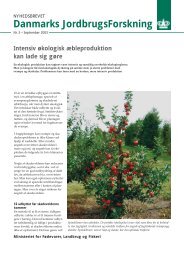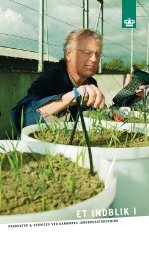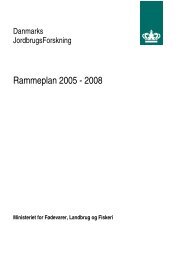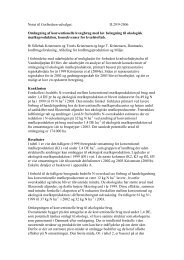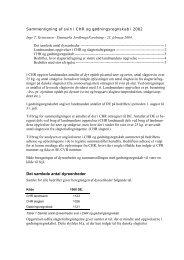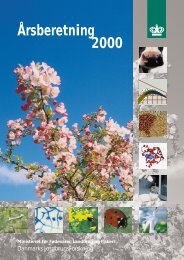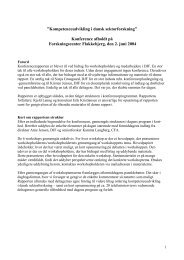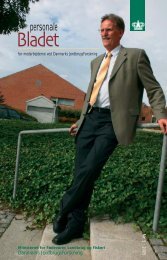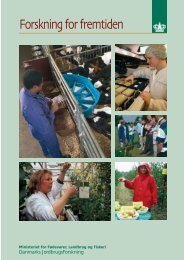Reproduction performances and conditions of group-housed non ...
Reproduction performances and conditions of group-housed non ...
Reproduction performances and conditions of group-housed non ...
Create successful ePaper yourself
Turn your PDF publications into a flip-book with our unique Google optimized e-Paper software.
- General discussion -<br />
However, an indicator is not necessarily well suited in an operational context just because<br />
the indicator is possible to perform in commercial herds <strong>and</strong> well related to the phenomena<br />
under study. Indicators applicable in a management tool should further be meaningful for<br />
the individual farmer (Halberg, 1996). It is e.g. important that the individual manager be-<br />
lieves that an indicator provides useful <strong>and</strong> relevant information, because otherwise he/she<br />
will not be motivated to use this as a management tool. Furthermore, it is essential that an<br />
indicator is possible to measure or register by farmers or advisors within reasonable time<br />
<strong>and</strong> costs (Halberg, 1996; Rousing et al., 2001; Sørensen et al., 2001). Whether the two<br />
indicators mentioned above meet these requirements will be discussed in the following.<br />
A systematic investigation <strong>of</strong> whether the indicators applied were perceived as meaningful<br />
by the farmers, e.g. by means <strong>of</strong> qualitative interviews (Vaarst, 2003) has not been carried<br />
out. However, <strong>non</strong>e <strong>of</strong> the farmers or managers questioned the relevance <strong>and</strong> usability <strong>of</strong><br />
the back fat measurements or the observations <strong>of</strong> eating behaviour at the introductive farm<br />
visits or during the recordings.<br />
Observation <strong>of</strong> eating behaviour. Time has become a very important issue in pig management,<br />
as the average labour input per animal has decreased (Madsen, 2001; Rasmussen,<br />
2003). The time necessary to observe sows’ eating behaviour was 10 to 25 minutes per<br />
batch as one <strong>group</strong> <strong>of</strong> sows were observed per batch <strong>and</strong> the recordings were carried out<br />
until the last sow had stopped eating or at longest 25 minutes after feeding start. Following<br />
four batches would then acquire between 40 m <strong>and</strong> 1.7 h plus the time required to select<br />
<strong>and</strong> mark ten r<strong>and</strong>om, focal sows. This seems as a feasible time range in most herds. However,<br />
the disadvantage <strong>of</strong> manually recording the eating behaviour is that a maximum <strong>of</strong> ten<br />
focal sows can be overviewed at a time. As a consequence here<strong>of</strong>, there is a risk that an<br />
existing problem will not be detected. This problem could, however, be overcome if the<br />
identification <strong>of</strong> sows with a low feed intake could be automated. O'Connell et al. (2003)<br />
report that low ranking sows visit the drinker more <strong>of</strong>ten than the high ranking in a <strong>group</strong> <strong>of</strong><br />
sows <strong>and</strong> according to own observations it seemed that sows with a very low feed intake<br />
<strong>of</strong>ten visited the drinker during feeding. Online registration <strong>of</strong> pigs’ drinking pattern as an<br />
indicator <strong>of</strong> e.g. an outbreak <strong>of</strong> diarrhoea has already been implemented as a commercial<br />
s<strong>of</strong>tware package, Farm Watch® (Madsen, 2001). Likewise, it might be possible to detect a<br />
feed-related problem in submissive sows by automatical registration <strong>of</strong> the water consumption<br />
during feeding. In that case, it would probably be possible to identify <strong>and</strong> pay special<br />
attention to ‘problem sows’ before the reproduction performance was influenced negatively.<br />
Back fat measurements. Assessment <strong>of</strong> back fat gain from weaning to three weeks after<br />
mating cannot be used for identifying individual sows with a potential reproduction prob-<br />
105




